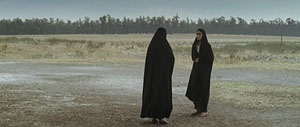
Bumped into my favorite NYC artist Shirin Neshat on the street in Soho on Saturday - or should I say I did that most un-New York thing and stopped her as she walking past !! Shirin Neshat's video "Faezeh," which I saw at the Gladstone gallery early in the year is still my favorite moving image of the year so far. The video is one of five large-scale video installations which were completed between 2004 and 2008. They all take their inspiration from the Shahrnush Parsipur’s Iranian novel "Women Without Men" which Neshat describes by saying - “Magic realism is a common style for artists in exile like Parsipur. People who have been forced from their homes tend to reach out for a universal vocabulary that transcends time and place. After all, how long can an exile depend on their memory? What if they don’t feel connected to the place where they live now? They might not foster an obsession for their new home. But art is an obsession—art has to be an urge, not something you calculate.”

Production still from Faezeh, 2008.
How did you come across Shahrnush Parsipur’s book Women Without Men?
Neshat: Women Without Men is a very well-known book in Iran. It was published in 1989 in Tehran, and subsequently banned along with all of Parsipur’s other work. Parsipur spent more than five years after the Islamic Revolution in 1979 in prison because of her writing, and she was imprisoned again for Women Without Men because she mentions virginity in the book. Most educated Iranians know about Women Without Men.
I had read Women Without Men some years ago, but had forgotten about it. When I was trying to find a project to bring to the Writers’ Workshop Lab at the Sundance Institute, Robert Redford’s organization for independent film, a friend of mine urged me to reread Women Without Men. When I reread it, I knew I wanted to work with it at Sundance as a film project.
What was it about the book that inspired you?
Neshat: Women Without Men is written in a tradition of magical realism where anything can happen. It is a wonderful, little book. The book tells the stories of five different women who are suffering from their life situations. The author Shahrnush Parsipur uses metaphorical and subversive language to explore the social and religious pressures that oppress these women who come from different classes in society in Tehran. Trying to escape society, the women eventually find themselves together in the garden of Karaj, a symbolic of Garden of Eden. There are lots of strong images in the book, like the image of Mahdokht obsessively knitting, which I felt would be interesting to work with visually.
Also, I was looking for material that would lend itself well to film. For me, film is about characters and narrative, and I was interested in the female characters and liked the loose narrative structure in Women Without Men. I had never tried to develop characters with personalities or psychologies before, so I needed characters that I could relate to. In my earlier work, people function more as symbols, or even sculptures. With respect to the narrative structure of Women Without Men, I found out after I had started working with the book that the chapters of the book had originally been written as separate stories and then later tied together in a final chapter where the characters meet each other in the garden. I guess this loose structure instinctively appealed to me.
I also really like the political aspect of the book. Women Without Men is set in 1953, an important year in the history of Iran. In 1953, a democratic government headed by Mohammed Mossadegh was brought down by a coup led by American and British forces. The coup reinstalled Shah Mohammed Reza Pahlavi as the absolute monarch. In the last chapter of Women Without Men, the women find themselves in the garden of Karaj trying to form a new society, a sort of alternative feminist utopia—again, a symbolic Garden of Eden. I have never worked on anything that was specifically political before, and I saw this as an opportunity to look into the political history of Iran. Not so much in the Women Without Men video installations, as in a feature length film which I expect to finish in about two months.
Let’s talk about the other part of your Women Without Men project, your full-length feature film. How will the feature-film of Women Without Men differ from the video installations?
Neshat: The video installations are inspired by the book Women Without Men, but do not follow the book closely. The film is also very different from the book. I have written a political narrative that develops throughout the film that is not in the book. In the book, the only chapter that is political is the last chapter. I have used the entire last chapter of the book in the film, exactly as it is in the book.
The film is a full-length feature film with a narrative and characters that develop over time. The characters also develop in the video progression, but these developments are more hidden. In the film, the character of Zarin, the young, anorexic prostitute, becomes an almost central character. Ironically, she becomes a redemptive savior figure; she has the hardest life, but also the biggest capacity to give. Also, the gardener becomes an important character in the film, as keeper of the garden of Karaj, a symbolic Garden of Eden.
But I shouldn’t give too much of the film away. You’ll have to wait and see it.

Neshat said to me that she hopes her first full length film " Women Without Men" will first be shown next January at Sundance. Something to look forward to in 2009 for sure.

No comments:
Post a Comment